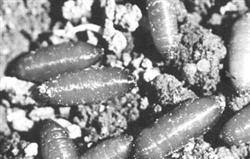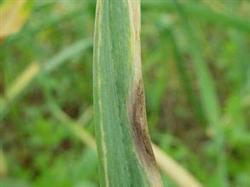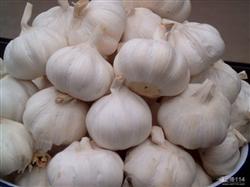Occurrence regularity and control methods of garlic root maggots

Root maggot is a general term for the larval stage of dipteran pests that damage crops such as garlic. In recent years, the occurrence of garlic root maggots showed an increasing trend year by year. Root maggot damage can cause garlic yield reduction, and has a greater impact on garlic quality, serious damage when the economic loss is serious. Garlic root maggots (larvae) generally gather in garlic roots and bulbs and other underground parts, mainly feeding or boring holes garlic roots caused incomplete, or drilling garlic cloves to feed holes and other ways of harm. Severe garlic meat was eaten empty, and the affected parts into rotten shape. The injured garlic plants are short on the ground, yellow leaves, and serious plants die. According to the occurrence regularity and damage characteristics of garlic root maggot, it is suggested that the integrated control strategy of agricultural control, physical control and chemical control should be adopted. 1. Physical control 1. Large removal of plant residues. Garlic root maggots have strong tropism to plant residues, especially rotten garlic plants. Garlic residues in fields, fields and roadsides should be completely removed and destroyed during garlic harvest to reduce food sources for root maggots and reduce residual insects in fields. 2. Regulate water, fertilizer and sowing plan to destroy the environment where root maggots occur. Organic fertilizer should be fully decomposed. Deep ploughing of the soil and raking of the topsoil to reduce insect population. According to the local specific conditions, the appropriate date late sowing. During the adult oviposition period, the soil surface should be kept dry to reduce the number of eggs laid by adults. 3. It traps adults. During the adult emergence period, 3~4 places of sweet and sour liquid (sugar: vinegar: water: 90% crystal trichlorfon =1∶1∶3∶0.1) can be placed per mu (1 mu =667m2) to trap adults. There are three main methods of chemical control: 1. Poison soil method. Combined with soil preparation, 15% chlorpyrifos granules 1~2 kg mixed with fine sand about 20 kg (or combined with chemical fertilizer) can better control root maggots. 2. Seed dressing. Chemical seed dressing before sowing is a better method to control garlic maggot at present. The available pesticides include Dagonglue (600g/L imidacloprid suspension seed coating agent) and Aocheng (40% chlorpyrifos aqueous emulsion). The specific application method is as follows: using 40g of large gong lue or 500g of Ao Cheng, mixing 2~ 3kg of water, mixing seed dressing solution, evenly mixing garlic about 100kg, drying in the shade and sowing. 3. Root irrigation. Garlic maggots occur, can be used root irrigation remedy. At the initial stage of root maggot larvae, watering and chemical application could control garlic maggot effectively. The specific application method is that 500 - 700g of Aocheng (40% chlorpyrifos aqueous emulsion) is used per mu, the mother liquor is prepared into a sprayer, the sprayer nozzle is removed, and the liquid medicine enters the garlic field along with watering. You can also remove the sprayer nozzle and spray it at the roots of garlic plants.
- Prev

Characteristics and control methods of gray leaf spot of garlic
The main results are as follows: (1) the symptom characteristics mainly harm the leaves. The disease spot is long oval, light brown at first, then gray-white, fine gray-black mildew on both sides of the leaf, and when the disease spot is serious, the disease spot converges, resulting in local death of the leaf. The sun is warm and the night is cool, and the foggy and dewy weather is serious. (2) ① was used to remove the injured leaves in time.
- Next

Garlic high yield to understand the characteristics of fertilizer
Garlic is a bulbous crop with large fertilizer requirement and high fertilizer tolerance. It is suitable for cultivation in sandy loam with rich organic matter, loose and fertile soil surface, comprehensive nutrition, good water and fertilizer conservation and ventilation. According to research: for every 1000 kg of fresh garlic produced, 4.5-5 kg of nitrogen, 1.1-1.3 kg of phosphorus and 4.1-4.7 kg of potassium are needed, and the ratio is 3.
Related
- Where is it suitable to grow horseradish in China? it is expected to see the middle altitude horseradish in Alishan.
- How to prevent tomato virus disease reasonably? (Control methods included)
- Many people like to plant towel gourd on the balcony. What are the main points of this method and management?
- What crops can chili peppers be mixed with?
- Fertilization techniques and matters needing attention in Tomato
- What are the grafting techniques for peach seedlings in spring?
- Harm and control methods of root swelling disease of Chinese cabbage
- What are the pests of sweet potatoes? How to prevent and cure it?
- Symptoms, causes and Control methods of navel Rot in Tomato
- The cause of "Cucumber rotten bibcock" in Farmers' planting Cucumber and its Control Plan

